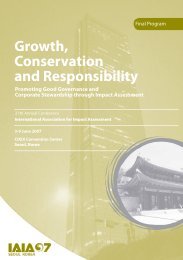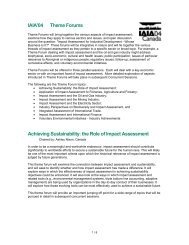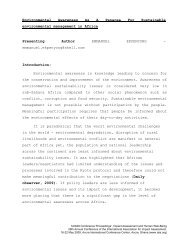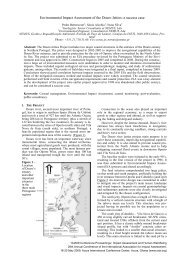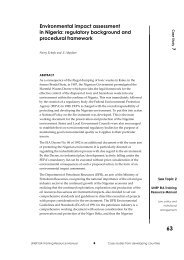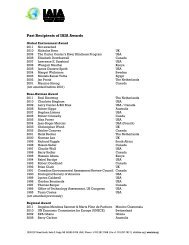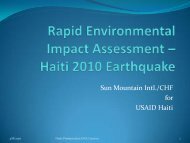Health Impact Assessment: international best practices principles.
Health Impact Assessment: international best practices principles.
Health Impact Assessment: international best practices principles.
Create successful ePaper yourself
Turn your PDF publications into a flip-book with our unique Google optimized e-Paper software.
IAIA\PUBS\SP5.indd (09/06)<br />
September 2006<br />
Special Publication Series No. 5<br />
<strong>Health</strong> <strong>Impact</strong> <strong>Assessment</strong><br />
PURPOSE<br />
These <strong>principles</strong> are intended to promote<br />
health impact assessment (HIA), to lead<br />
to better consideration of the health implications<br />
of decisions and render them more<br />
sustainable.<br />
They should help practitioners to integrate<br />
health into impact assessment (IA), decision-makers<br />
to commission and review<br />
IAs and other stakeholders to ensure that<br />
health concerns and aspirations are addressed<br />
in development planning.<br />
BACKGROUND<br />
<strong>Health</strong> is a cross-cutting theme relevant<br />
to all fields of IA. These <strong>principles</strong> should<br />
therefore be read in conjunction with the<br />
other <strong>principles</strong> of <strong>best</strong> practice provided<br />
by IAIA.<br />
IAIA and the World <strong>Health</strong> Organization<br />
(WHO) have a Memorandum of<br />
Understanding for collaboration in the<br />
area of HIA.<br />
IAIA is actively developing a comprehensive<br />
series of Principles and Practice<br />
papers covering a wide range of important<br />
issues which need to be covered in IA.<br />
Many of the papers produced are devised<br />
by the IAIA Sections and this one is no<br />
exception. IAIA has an active <strong>Health</strong> Section,<br />
members of which have been instrumental<br />
in both requesting and developing<br />
these <strong>principles</strong>.<br />
The <strong>principles</strong> were prepared by the <strong>Health</strong><br />
Section of IAIA; comments are welcome<br />
at any time and should be forwarded to<br />
the current Chair of the <strong>Health</strong> Section via<br />
info@iaia.org.<br />
HOW TO CITE THIS PUBLICATION<br />
Quigley, R., L. den Broeder, P. Furu, A.<br />
Bond, B. Cave and R. Bos 2006 <strong>Health</strong><br />
<strong>Impact</strong> <strong>Assessment</strong> International Best<br />
Practice Principles. Special Publication<br />
Series No. 5. Fargo, USA: International<br />
Association for <strong>Impact</strong> <strong>Assessment</strong>.<br />
.<br />
INTERNATIONAL<br />
ASSOCIATION for<br />
IMPACT ASSESSMENT<br />
• Headquarters<br />
1330 23rd Street South, Suite C<br />
Fargo, ND 58103-3705 USA<br />
Phone +1.701.297.7908<br />
Fax +1.701.297.7917<br />
info@iaia.org<br />
www.iaia.org<br />
<strong>Health</strong> <strong>Impact</strong> <strong>Assessment</strong><br />
International Best Practice Principles<br />
HEALTH IMPACT ASSESSMENT MAY BE DEFINED AS A COMBINATION OF<br />
PROCEDURES, METHODS AND TOOLS THAT SYSTEMATICALLY JUDGES THE<br />
POTENTIAL, AND SOMETIMES UNINTENDED, EFFECTS OF A POLICY, PLAN,<br />
PROGRAMME OR PROJECT ON THE HEALTH OF A POPULATION AND THE<br />
DISTRIBUTION OF THOSE EFFECTS WITHIN THE POPULATION. HIA IDENTIFIES<br />
APPROPRIATE ACTIONS TO MANAGE THOSE EFFECTS.<br />
(ADAPTED FROM WORLD HEALTH ORGANIZATION, 1999)<br />
The underpinning concept of HIA<br />
Individual and population health status is largely the result of the social, cultural and physical<br />
environment in which we live. Factors such as the state of our environment, access to resources<br />
to meet our basic needs, our exposure to risks and capacity to cope with these, our income and<br />
education level, and our social network of relationships with friends, family and neighbors all<br />
have considerable impacts on health and well-being.<br />
Human health and the physical and social environment are intricately linked. Human health has<br />
a number of determinants that go beyond individual lifestyle choices (examples in Table 1):<br />
1. Determinants related to the individual: genetic, biological, lifestyle/behavioral and/or<br />
circumstantial.<br />
2. Social and environmental determinants: physical, community conditions and/or<br />
economic/financial.<br />
3. Institutional determinants: the capacity, capabilities and jurisdiction of public sector<br />
institutions and the wider public policy framework supporting the services they provide.<br />
What is <strong>Health</strong> <strong>Impact</strong> <strong>Assessment</strong>?<br />
<strong>Health</strong> <strong>Impact</strong> <strong>Assessment</strong> (HIA) aims to identify how development induces unintended changes<br />
in health determinants and resulting changes in health outcomes. HIA provides a basis to proactively<br />
address any risks associated with health hazards. HIA also addresses health improvement<br />
opportunities in development. <strong>Health</strong> hazards, risks and opportunities also may be addressed<br />
explicitly in environmental assessment.<br />
Development planning is typically conducted outside the health sector and is concerned with<br />
social and economic development, for example, energy, agriculture, industry and transport. With<br />
a considerably larger proportion of resources at their disposal, and with a responsibility for action<br />
that may change environmental and social health determinants significantly, these other sectors<br />
outstrip the health sector in the potential to affect, protect and promote population health.<br />
Development planning without adequate consideration of human health may pass hidden<br />
“costs” on to affected communities, in the form of an increased burden of disease and reduced<br />
well-being. From an equity point of view, it is often marginalized and disadvantaged groups<br />
who experience most of these adverse health effects. From an institutional point of view, it is<br />
the health sector that must cope with development-induced health problems and to which the<br />
costs are incurred of dealing with an increased disease burden.<br />
HIA provides a systematic process through which health hazards, risks and opportunities can be<br />
identified and addressed upstream in the development planning process, to avoid the transfer<br />
of these hidden costs and to promote multisectoral responsibility for health and well-being. The<br />
production of public health management plans with safeguards, mitigating measures and health<br />
promotional activities is an integral part of HIA.
Key <strong>principles</strong> of HIA are presented in the three sections that follow:<br />
1. “What is HIA” provides a definition of its scope, indicates the<br />
key determinants to be considered and outlines the main functions<br />
and purpose of the HIA process.<br />
2. “Guiding <strong>principles</strong>” apply to all stages and types of IA; this<br />
section explains the basic values and how a desired outcome<br />
can be achieved for health and well-being.<br />
3. “Operating <strong>principles</strong>” explains how health concerns and<br />
aspirations are <strong>best</strong> addressed in the main stages of the IA process.<br />
What is HIA?<br />
HIA systematically reviews the health hazards and health promoters<br />
associated with a development policy or project. It assesses risk factors<br />
associated with hazards and opportunities associated with promoters<br />
as they change in the course of a development activity, and it develops<br />
evidence-based recommendations to inform the decision making process<br />
on health protection and promotion.<br />
The recommended measures should be technically sound, socially acceptable<br />
and economically feasible.<br />
The appropriate actions, which are identified in an HIA, may be presented<br />
as a Public <strong>Health</strong> Management Plan. This intersectoral management<br />
plan explicitly includes safeguards to health and mitigating measures<br />
which may fall outside the remit of the health sector. The Public <strong>Health</strong><br />
Management Plan can also include provision for adapted health services.<br />
Most importantly it provides for the monitoring of compliance and the<br />
evolution of health status.<br />
HIA attempts to clarify health implications by disaggregating the determinants<br />
of health and well-being (examples listed in Table 1) (Public<br />
<strong>Health</strong> Advisory Committee, 2005).<br />
HIA investigates the pathways of how the inter-related determinants may<br />
be affected by a proposed policy, programme or project. It aims to trace<br />
the changes through to their impact on health status. Some of the pathways<br />
are direct (such as pollution and asthma admissions to hospitals);<br />
others may be indirect (such as traffic density and community severance,<br />
leading to changes in several health outcomes) (Dahlgren, 1995).<br />
The dimensions of HIAs (scope and time frame) will vary. Each HIA<br />
must be suitable for the context within which it is undertaken, it must<br />
be affordable and its costs must be proportional to the overall project<br />
budget. Supporting flexibility in approach is critical for maintaining the<br />
practical use of HIA. The size of a team carrying out a given HIA will<br />
vary accordingly.<br />
Table 1. Examples of the determinants of health<br />
Categories of determinants<br />
of health<br />
Individual factors: genetic,<br />
biological, lifestyle/behavioral<br />
and/or circumstantial.<br />
Some of these factors can be<br />
influenced by proposals and<br />
plans, others cannot.<br />
Social and environmental<br />
factors: physical, community<br />
and/or economic/financial<br />
conditions.<br />
Institutional factors: the<br />
capacity, capabilities and<br />
jurisdiction of public sector<br />
services.<br />
Purpose and functions of HIA<br />
Examples of specific health determinants<br />
Gender, age, dietary intake, level of<br />
physical activity, tobacco use, alcohol<br />
intake, personal safety, sense of<br />
control over own life, employment<br />
status, educational attainment, self<br />
esteem, life skills, stress levels, etc.<br />
Access to services and community<br />
(health, shopping, support, etc.); social<br />
support or isolation; quality of<br />
air, water and soil; housing; income;<br />
distribution of wealth; access to safe<br />
drinking water and adequate sanitation;<br />
disease vector breeding places;<br />
sexual customs and tolerance;<br />
racism; attitudes to disability; trust;<br />
land use; urban design; sites of cultural<br />
and spiritual significance; local<br />
transport options available; etc.<br />
Availability of services, including<br />
health, transport and communication<br />
networks; educational and employment;<br />
environmental and public<br />
health legislation; environmental<br />
and health monitoring systems;<br />
laboratory facilities; etc.<br />
The purpose of all HIA is to inform and influence decision making on<br />
proposals and plans, so health protection and promotion are effectively<br />
integrated into them.<br />
Linked to this central purpose, HIA has an important function contributing<br />
to healthy projects and healthy public policy. Some examples:<br />
1. HIA involves and engages health experts, project proponents,<br />
other key players and the community affected by the proposal,<br />
and facilitates public participation in decision making 1 .<br />
2. HIA attempts to identify health inequalities that may arise from<br />
a proposal.<br />
3. HIA addresses cross-cutting health issues with repercussions for<br />
sustainability.<br />
4. HIA helps place public health on the agenda of many different<br />
agencies and individuals and increases awareness of what determines<br />
health status, thereby providing a basis for improved<br />
collaboration within and between agencies.<br />
5. HIA provides a “license to operate,” not only for public bodies,<br />
but also for private sector companies who incorporate social<br />
and health responsibility into their activities.<br />
6. HIA is a tool for intersectoral action for health.<br />
7. HIA focuses on the health status of vulnerable groups.<br />
8. HIA may reduce the burden on health sector services.<br />
_________________________________<br />
1<br />
The attempt to involve communities in an HIA is seen as a strength. IAIA has a public<br />
participation <strong>principles</strong> and practice paper (Special Publications Series No. 4, 2006)<br />
2<br />
HEALTH IMPACT ASSESSMENT INTERNATIONAL BEST PRACTICE PRINCIPLES<br />
International Association for <strong>Impact</strong> <strong>Assessment</strong>
Who does HIA?<br />
HIAs are typically commissioned by:<br />
• Local, regional and national governments<br />
• Local, regional and national health authorities/departments<br />
• Local, regional and national planning authorities/departments<br />
• National and <strong>international</strong> development banks/ bi- and multilateral<br />
donors<br />
• Private industry<br />
Practitioners usually have a diverse background of skills and experiences.<br />
There are no accreditation schemes for practitioners as yet, and a mix of<br />
skills is often developed and used. There is currently more experience of<br />
HIA at the program and at the project level than at the strategic level.<br />
Training courses exist in some countries to assist practitioners and to<br />
develop capacity (particularly since capacity to undertake HIA is low in<br />
most countries). The skills required to undertake HIA are many, but they<br />
need not be held by one individual and should instead be present across<br />
the team of people undertaking the HIA. As an individual, the <strong>best</strong> way<br />
to develop HIA skills is to participate in or undertake an HIA.<br />
Writing Terms of Reference (TOR) for full scale HIAs should be undertaken<br />
collaboratively by the Ministry of <strong>Health</strong> (MOH) (central or peripheral levels)<br />
and other relevant authorities. The MOH may also be in charge of the<br />
critical appraisal of the consultants’ HIA report with its recommendations<br />
for mitigation of negative health impacts and enhancement of positive<br />
impacts. There is currently a lack of capacity among authorities on how<br />
to develop TOR and critically appraise the quality of HIA reports. The<br />
agreed procedures for HIA should reflect the responsibilities of different<br />
actors at different stages.<br />
Generally, the leader of an HIA team would be a professional with a<br />
broad public health outlook rather than one with a narrow medical area<br />
of expertise. The expertise of an HIA team should reflect the complexity<br />
of the health determinants associated with a given project, programme<br />
or plan (e.g., public health, natural and social science, economics) and<br />
the key health issues identified at the screening phase.<br />
Guiding <strong>principles</strong> for HIA<br />
The Gothenburg consensus paper (World <strong>Health</strong> Organization, 1999)<br />
indicates that values are framed by society, the government in power,<br />
the sector and the people working in the sector within which a proposal<br />
is placed. These values of HIA are:<br />
• Democracy – emphasizing the right of people to participate in<br />
the formulation and decisions of proposals that affect their life,<br />
both directly and through elected decision makers. In adhering<br />
to this value, the HIA method should involve and engage the<br />
public, and inform and influence decision makers. A distinction<br />
should be made between those who take risks voluntarily<br />
and those who are exposed to risks involuntarily (World <strong>Health</strong><br />
Organization, 2001).<br />
• Equity – emphasizing the desire to reduce inequity that results<br />
from avoidable differences in the health determinants and/or<br />
health status within and between different population groups 2 .<br />
_________________________________<br />
2<br />
For example, across ages, genders, ethnic groups and geographic locations, etc.<br />
In adhering to this value, HIA should consider the distribution<br />
of health impacts across the population, paying specific attention<br />
to vulnerable groups 3 and recommend ways to improve the<br />
proposed development for affected groups.<br />
• Sustainable development – emphasizing that development meets<br />
the needs of the present generation without compromising the<br />
ability of future generations to meet their own needs. In adhering<br />
to this value, the HIA method should judge short- and longterm<br />
impacts of a proposal and provide those judgements within<br />
a time frame to inform decision makers. Good health is the basis<br />
of resilience in the human communities that support development.<br />
• Ethical use of evidence – emphasizing that transparent and rigorous<br />
processes are used to synthesise and interpret the evidence,<br />
that the <strong>best</strong> available evidence from different disciplines and<br />
methodologies is utilized, that all evidence is valued, and that<br />
recommendations are developed impartially. In adhering to this<br />
value, the HIA method should use evidence to judge impacts<br />
and inform recommendations; it should not set out to support or<br />
refute any proposal, and it should be rigorous and transparent.<br />
• Comprehensive approach to health – emphasizing that physical,<br />
mental and social well-being is determined by a broad range of<br />
factors from all sectors of society (known as the wider determinants<br />
of health). In adhering to this value, the HIA method<br />
should be guided by the wider determinants of health.<br />
Operating <strong>principles</strong> for HIA<br />
HIA process<br />
The following represents key steps in the HIA process and suggested<br />
responsibilities for each step:<br />
1. Screening: deciding what scale, if any, HIA is required (desk<br />
exercise by ministry/authority).<br />
2. Scoping: setting the boundaries in time and space for the assessment<br />
and formulating TOR for a full scale HIA accordingly<br />
(usually by MOH (central, province and/or district) and key<br />
stakeholders).<br />
3. Full scale HIA (by HIA team according to specifications in TOR).<br />
4. Public engagement and dialogue (initiated by MOH or other<br />
relevant authority).<br />
5. Appraisal of the HIA report (compliance with TOR, quality<br />
control of independent criteria) and the feasibility/soundness/<br />
acceptability of its recommendations (MOH or another MOHassigned<br />
independent consultant).<br />
6. Establishment of a framework for intersectoral action (MOH and<br />
relevant ministries).<br />
7. Negotiation of resource allocations for health safeguard measures<br />
(Ministry of Finance and relevant ministries).<br />
8. Monitoring (of compliance and of pertinent health indicators),<br />
evaluation and appropriate follow-up (MOH and line ministries).<br />
_________________________________<br />
3<br />
Groups can be vulnerable due to their physical status (e.g., children, older people, disabled<br />
people) or due to their social positions (e.g., people with low socioeconomic status,<br />
ethnic minorities, women).<br />
HEALTH IMPACT ASSESSMENT INTERNATIONAL BEST PRACTICE PRINCIPLES<br />
International Association for <strong>Impact</strong> <strong>Assessment</strong> 3
HIA methods<br />
The HIA team works according to specific TOR for the assignment in question.<br />
The TOR may suggest specific methods to be used by the assessor<br />
and emphasize the need to share information produced by environmental<br />
and social IA teams working in parallel with the HIA team. Examples of<br />
methods include:<br />
• Collection and analysis of appropriate secondary data from<br />
relevant authorities (e.g., national or district health statistics,<br />
environmental and demographic data).<br />
• Interviewing key informants and conducting focus group discussions<br />
in stakeholder groups (participatory approaches).<br />
• Direct field observations in the bio-physical, social and institutional<br />
environments.<br />
• Mapping using Geographical Information Systems.<br />
• Review of relevant scientific and “gray” literature.<br />
In most cases, there is no time for cross-sectional epidemiological surveys,<br />
but these may be carried out as part of the assessment in projects with<br />
exceptionally long planning stages, such as large dams. Where appropriate,<br />
integrated assessment may be introduced to benefit from a joint methodological<br />
approach saving time and reducing cost of the assessment.<br />
Policy HIA<br />
Although HIA is often carried out on a project level, broader policies, such<br />
as employment, trade, education and strategic spatial planning policies<br />
can, and are, also assessed for health impacts. The aim of HIA of policies<br />
is, again, to prevent health damage and enhance opportunities for health<br />
improvement. As such, HIA is a tool for the development of healthy public<br />
policy, guaranteeing a “<strong>Health</strong> in All Policies” approach.<br />
<strong>Health</strong> in Environmental<br />
<strong>Assessment</strong><br />
Strategic Environmental <strong>Assessment</strong> (SEA) at the strategy, policy and<br />
programme level and environmental impact assessment (EIA) at the<br />
project level have traditionally addressed health issues. Human health<br />
is, however, often a single bullet point on an EIA or SEA check list. The<br />
assessment of health effects is likely to be biased towards bio-physical<br />
health determinants rather than a holistic view that also includes important<br />
wider determinants. The scope of health issues covered may<br />
reflect the industrial country roots of EIA, and therefore lack the level of<br />
comprehensiveness necessary to make the assessment fully relevant to<br />
local health conditions.<br />
Most importantly, EIA procedures frequently do not recognize the fact that<br />
the ultimate authority for health pertains to Ministries of <strong>Health</strong> (central<br />
or peripheral levels), which should have the regulatory responsibilities for<br />
the planning, quality control and final approval of any assessment of the<br />
impact on health and its follow-up. In that case, care needs to be taken:<br />
• To ensure health is covered comprehensively.<br />
• To strike an acceptable balance between strengthening of health<br />
services and design and operational measures by other sectors to<br />
safeguard health and well-being.<br />
• To adequately address the wider determinants of health.<br />
• To anchor the final authority for the health component with the<br />
Ministry of <strong>Health</strong>.<br />
Glossary<br />
<strong>Health</strong>: A state of complete physical, mental and social well-being and<br />
not merely the absence of disease or infirmity (World <strong>Health</strong> Organization,<br />
1948).<br />
<strong>Health</strong> hazard: An agent with a potential to create ill health (e.g., bacteria,<br />
toxins, chemicals).<br />
<strong>Health</strong> risk: Indicates the extent to which the potential of a hazard may<br />
be realized.<br />
<strong>Health</strong> promoter: An agent with a potential to enhance health status<br />
(e.g., anti-oxidants, constituents of medicinal plants).<br />
<strong>Health</strong> determinants: The range of personal, social, economic and<br />
environmental factors which determine the health status of individuals<br />
or populations (NIHCE, 2006).<br />
<strong>Health</strong> outcome: A change in the health status of an individual, group<br />
or population which is attributable to a planned intervention or series of<br />
interventions, regardless of whether such an intervention was intended<br />
to change health status.<br />
<strong>Health</strong> inequality: Differences in health status or in the distribution of<br />
health determinants between different groups of a population. They occur<br />
as a consequence of differences in social and educational opportunities,<br />
financial resources, housing conditions, nutrition, work patterns and<br />
occupational conditions and unequal access to health services (NIHCE,<br />
2006).<br />
<strong>Health</strong> inequity: Is a term that has a moral and ethical dimension<br />
– where inequities can result from avoidable and unjust differences in<br />
health status (Scott-Samuel, 1996).<br />
Methods and tools web sites<br />
http://www.who.int/hia<br />
http://www.who.int/water_sanitation_health/resources/hia/en/index.html<br />
http://www.hiagateway.org.uk<br />
http://www.hiadatabase.net<br />
http://www.who.dk/eprise/main/WHO/Progs/HMS/Home<br />
http://www.hc-sc.gc.ca/ewh-semt/pubs/eval/index_e.html<br />
References<br />
Dahlgren, G .1995. European health policy conference: Opportunities for the<br />
future. Vol 11 – Intersectoral action for health. Copenhagen: WHO Regional<br />
Office for Europe.<br />
National Institute for <strong>Health</strong> and Clinical Excellence 2006 HIA Gateway web site<br />
(2006). Available at http://www.hiagateway.org.uk. Last accessed 26/09/06.<br />
André, P., B. Enserink, D. Connor and P. Croal 2006 Public Participation International<br />
Best Practice Principles. Special Publication Series No. 4. Fargo, USA:<br />
International Association for <strong>Impact</strong> <strong>Assessment</strong>.<br />
Public <strong>Health</strong> Advisory Committee 2005. A guide to health impact assessment: A<br />
policy tool for New Zealand. Wellington: Public <strong>Health</strong> Advisory Committee.<br />
Scott-Samuel, A. 1996 <strong>Health</strong> impact assessment: An idea whose time has come.<br />
BMJ, 313:(27 July), pages 183-4.<br />
World <strong>Health</strong> Organization 1948 Constitution of the World <strong>Health</strong> Organization.<br />
Geneva: World <strong>Health</strong> Organization.<br />
World <strong>Health</strong> Organization 1999 <strong>Health</strong> impact assessment: main concepts and<br />
suggested approach European Centre for <strong>Health</strong> Policy, Copenhagen: WHO<br />
Regional Office for Europe.<br />
World <strong>Health</strong> Organization 2001 <strong>Health</strong> <strong>Impact</strong> <strong>Assessment</strong>. Harmonization,<br />
mainstreaming and capacity building. Report of a WHO inter-regional meeting<br />
(Arusha, 31 October-3 November 2000), WHO/SDE/WSH/01.07. Geneva: World<br />
<strong>Health</strong> Organization.<br />
4<br />
HEALTH IMPACT ASSESSMENT INTERNATIONAL BEST PRACTICE PRINCIPLES<br />
International Association for <strong>Impact</strong> <strong>Assessment</strong>


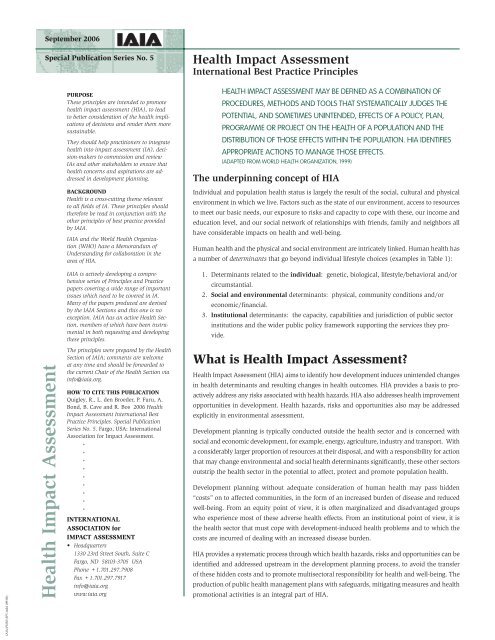

![Session Report [PDF] - International Association for Impact Assessment](https://img.yumpu.com/22416146/1/190x245/session-report-pdf-international-association-for-impact-assessment.jpg?quality=85)
![Session Report [PDF] - International Association for Impact Assessment](https://img.yumpu.com/22416140/1/184x260/session-report-pdf-international-association-for-impact-assessment.jpg?quality=85)
